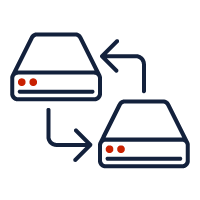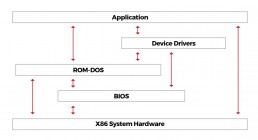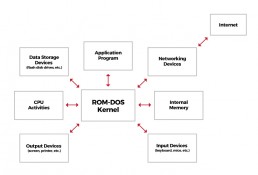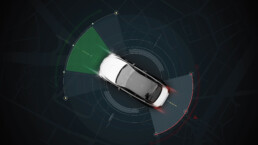About ROM-DOS
ROM-DOS was introduced in 1989 as an MS-DOS compatible operating system engineered specifically for embedded developers. The most robust DOS available on the market, ROM-DOS enables current desktop hardware in legacy implementations. ROM-DOS continues to have backward compatibility build options. It’s also the fastest way to connect an embedded system to the internet.
OEMs are now able to take advantage of large disk drives and Long File Names with ROM-DOS 7.1. With as little as a 186 CPU, a small amount of RAM and flash memory or other non-volatile storage, you can create a low cost system in no time.
ROM-DOS benefits

Embedded design features
ROM-DOS was specifically designed for use in embedded systems, and its features make it uniquely suited to embedded devices.

Connectivity tools
ROM-DOS incorporates a suite of tools, including a compact TCP/IP stack that is designed to advance the embedded device market from stand-alone to Internet-enabled. ROM-DOS supports applications that provide embedded systems with the ability to send and receive e-mail, securely transfer files via FTP, run a private remote console or be viewed from a local web browser.

Foundational OS
ROM-DOS provides the closest, most direct access to x86 hardware. No other operating system can be integrated this closely with underlying hardware. This unique ability allows ROM-DOS to serve as a foundational operating system, running either underneath or alongside another operating system. Used in this manner, ROM-DOS stabilizes the underlying device operation, creating a consistent environment in which the companion OS can run to its full potential.

Product technical support
Tuxera’s team of file system experts will support you from evaluation to implementation to ensure your project performs flawlessly and on schedule.
ROM-DOS target device requirements
- 186 or higher processor.
- ROM-based operation requires 60K to 90K of ROM or Flash.
- Internet connectivity requires a packet driver or modem connection.
How ROM-DOS works
In any computer system, an operating system has many responsibilities. Operating systems perform basic tasks, such as recognizing input from the keyboard, sending output to the display screen, keeping track of files and directories on the disk and controlling peripheral devices such as disk drives and printers. They also serve as the software platform on top of which other application programs can run. The application programs must be written to run on top of a particular operating system.
ROM-DOS™ provides a well-known, well-documented interface for application programs to send and receive information for other devices throughout the computer. Although it is possible to design application programs that bypass the operating system and communicate directly to hardware, this is generally ill advised. Since ROM-DOS is responsible for such activities as disk access and memory allocation, bypassing ROM-DOS and communicating directly to the hardware is like sky diving without a second chute. You can do it, but if something goes wrong, you are in for a world of trouble.
ROM-DOS communicates to the application and device drivers through the use of defined interrupts. For stability and efficiency, applications should be designed so that all communication from the application runs through the ROM-DOS kernel.

Designing a system so that all access to devices and system resources runs through the ROM-DOS kernel provides a high level of stability, enabling systems to run unmonitored without needing to reboot for extended periods of time.

ROM-DOS product details
ROM-DOS™ is the industry leader of DOS technologies and delivers features including kernel level FAT32 and Long File Name support. Our company offers source code modules in library and assembly format that allow developers control over their DOS. We are committed to ROM-DOS for the long-run, and continues to provide technical support.
ROM-DOS contains embedded features such as a configurable ROM-DOS BUILD utility.
The ROM-DOS BUILD Utility enables developers to include or exclude a variety of features such as Kernel options, device drivers, FAT32 and Long File Name support, and other ROM-DOS capabilities. By removing these, a smaller footprint can be generated providing more memory for application and data storage.
ROM-DOS incorporates a suite of tools, including a compact TCP/IP stack, that advance the embedded device from stand-alone to Internet enabled. The SOCKETS suite supports applications that provide embedded systems with the ability to send and receive email, transfer files via FTP, run a remote console or be viewed from a local web browser.
- E-Mail - The system can be controlled remotely via specific e-mail messages that control the system behavior. Notification can be delivered to a server that monitors many systems, or to an operator via a message to a desktop e-mail address, cell phone or pager.
- Optional 32 bit Sockets Kernel - Socket32 provides a stand-alone interactive 32 bit TCP/IP stack that contains FTP and Telnet clients, HTTP, Remote Console, Echo, UDP and Discard servers, WebDOS Commander, CGI Demo and status console including protocol tracing facilities. Socket32 is based on the DJGPP compiler tools and offers conventional RAM savings over the real-mode Sockets kernel. Contact for more information and instructions on downloading this SDK add-on.
- Web Server - SOCKETS provides a web server that allows an embedded system to be viewed and controlled from a web browser. Change application variables using the Server Side Includes (SSI) functionality. Other applets can be spawned using the Common Gateway Interface (CGI) in the web server.
- Security - User authentication is performed on multiple levels. The web server uses a password file to define the rights of a connecting client. A second access file has the ability to assign specific access rights on a directory level. The remote call back feature has the host system call the remote system; the remote system detects the call and hangs up immediately. It then calls the host at a predetermined phone number. This is one of the most economical security options.
- File Transfer - Files can be sent and received from a SOCKETS system using the Internet standard File Transfer Protocol (FTP) with the FTP server. This enables a user to update applications running on the remote system or retrieve data files from the system.
- Remote Console - Allows access through Microsoft® Internet Explorer and appears as a DOS box on the browser. Status on the remote embedded system can be easily monitored. Applications such as diagnostics can easily be run and results read and presented in HTML format where a DOS box isn't preferred.
ROM-DOS supports full file access on standard Desktop FAT32 disks, the FAT16 hard disk format used for today’s Compact Flash cards, and the FAT12 used for the smallest types of removable media like floppy disks. Also Microsoft® Windows® Long File Names are supported for any of these disk formats.
- FAT32 - Windows hard disks are supported with FAT32. The disk support is completely transparent to the application program, so no application changes are required to access files on huge disks. No new API's are required to support these disks.
- FAT16 - ROM-DOS supports the standard FAT16 disk format for Compact Flash Cards or other smaller disk formats.
- Long Filename Support (LFN) - Files on any size disk can be accessed easily with Long File Names. Long File Names can be read, written and deleted with ROM-DOS. Long File Names are accessed using the standard Windows / DOS APIs.
Datalight reduces time to market by providing a suite of tools that enables rapid application development needed to complete a product on time.
Software Development Toolkit (SDTK) – The ROM-DOS SDTK includes Borland C compiler and linker, Turbo Assembler as well as tools developed by Datalight engineers for use specifically with Datalight products.
The Datalight Software Development Toolkit (SDTK) supports Datalight ROM-DOS™ based products, including FlashFX® for ROM-DOS, with a standard development environment. The SDTK supplements Datalight DOS-based products by providing all of the tools necessary to complete configuration, development and deployment of both Datalight software and OEM applications. The tools include third party programs such as the Borland C/C++ 5.2 compiler and linker as well as a library of DOS development and debugging tools developed by Datalight.
Availability
The SDTK is shipped with the purchase of the ROM-DOS Software Development Kit and is available to existing Datalight customers.
System Requirements
Minimal system requirements include Windows 95/98/NT and 100MB for command line tools, 450MB for the full Borland Integrated Development Environment.
Contents
Tool/Utility
- Borland C/C++
- Turbo Assembler
- NED
- LOC
- PROMERGE
- RECURSE
- PROTO
Description
- Full C/C++ compiler, linker, tools, example and help files for DOS and Windows environments
- Assembly language compiler that supports the 8086 through 586 class machines
- A full-featured, full-screen editor for DOS that provides simultaneous access to multiple files
- Binary locate tool for developing ROM-able application and BIOS extensions
- Merges multiple files into a binary image suitable for a PROM burner
- Repeats any command in all subdirectories
- Creates prototypes from C source files
Get ROM-DOS
What we're talking about
News and updates about embedded file systems
November 21, 2024
Are you ready to fail?
November 14, 2024
What is SMB and why does it matter for file sharing?
November 14, 2024
How to optimize metadata management in Linux file systems
October 17, 2024









